
Fire is an agent of change in forests, shrublands, grasslands, and other ecosystems. Every year, thousands of lightning strikes occur in and near Lassen, and when it is dry and warm, and there is enough fuel to burn, fires may ignite. When conditions are safe, a lightning fire may be sometimes be allowed to burn to benefit forest health. 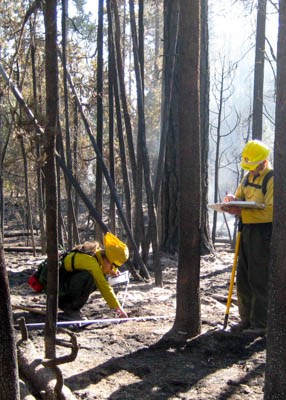
How Do We Learn about Fire Effects?A National Park Service Fire Monitoring Program began in the 1980s. This program uses long-term monitoring locations or plots, to track how trees and shrubs respond to lightning-caused fires and prescribed burns ̶ how many individuals of each species are present before and after fire. They also measure the amount of fuel (dead branches, logs, pine needles, and other materials on the ground that can burn). During the fire, scientists measure current weather conditions, how much moisture is in the woody fuels, and how the fire is burning. The plots they install are re-measured over time, and provide information to managers about how fires affect woody plants, if prescribed burn objectives have been achieved, and when an area may need to be burned again. How Do Fire Regimes Influence Fire Effects?As all forests are not alike, neither are the types of fire that burn in them. Fire managers need to know about the characteristics of a fire regime to effectively manage and restore fire. A fire regime is the naturally-occurring pattern of fire in a particular vegetation type or specific location. Fire regime characteristics include:
Historically, Lassen’s fire regime was classified as “mixed severity” and fires occurred an average of every 5-15 years, depending on elevation and forest type. Lower elevation forests had more frequent fire than higher elevation forests because they are warmer and drier and typically have more flammable fuels. Mixed severity means there are many small patches of burned area and a few large patches. Some patches are high severity – killing most vegetation – while others are unburned, low, or moderate severity. This mix creates what fire managers call a mosaic, almost like a quilt pattern of different fire effects. These diverse patches help make a landscape more resilient to drought and future wildfires. However, in the past decade, due to dense forests from lack of fire, and a drier, warmer climate, fires are burning larger areas at high severity. 
Calvin Farris / National Park Service 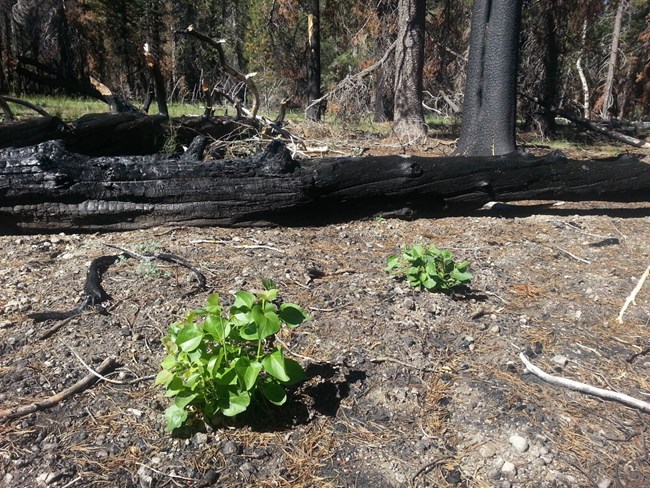
Fire Effects on PlantsFire creates opportunities for plant growth by burning logs, sticks, and tree needles on the forest floor and releasing nutrients into the soil; fire also opens up gaps in the forests, creating more light for tree seedlings, shrubs, and other plants that may not thrive under a shady forest. For trees and shrubs that survive the fire and are not injured, growth may increase from the extra nutrients and light and the reduced competition from plants that died in the fire. 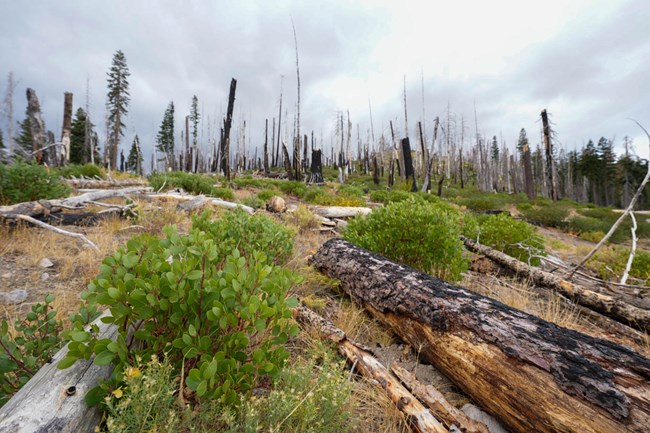
Some species of shrubs, like common manzanita, will germinate readily after fire from a soil seed bank, with seeds stimulated to grow by the fire’s heat. Many herbaceous plants may also grow from seeds in the soil, or sometimes re-sprout from deep roots. Conifer trees store seeds in cones, and some species like lodgepole pine have increased seed release after fire. Most pines need open, sunny areas for their seedlings to take root and grow. In forests lacking fire for many decades, shade-tolerant fir trees become more common and may gradually replace pines, which need open, sunny conditions. 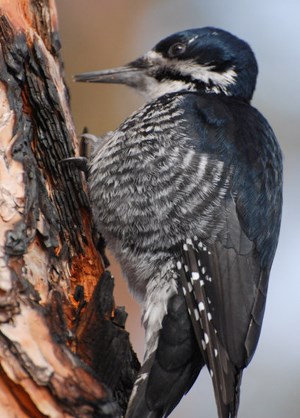
Mike Laycock, National Park Service. Flickr (CC BY-NC 2.0), Fire Effects on AnimalsLike native plants, most animals in the park have evolved with fire. Many large mammals like deer and bears may be able to move out of the way or flee a fire. Most small animals such as rodents, amphibians, and reptiles avoid fire by seeking refuge in tunnels or burrows, under large downed logs, or in damp areas such as meadows or streams. But many animals may die in a high-severity fire. Later, wildlife populations re-establish, in parallel with post-fire growth of vegetation. 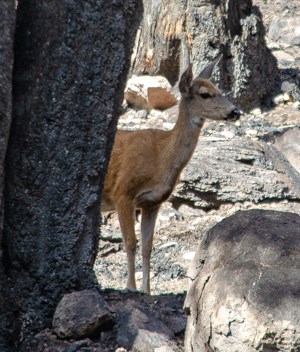
Grazing animals (rodents, ground squirrels, rabbits) and browsers (such as deer) may find more vegetation to feed on as shrubs and other plants thrive in areas made more favorable to plant growth with increased sun and soil nutrients. Even spotted owls, a species favoring old-growth forest, may benefit from more open burned patches where they can hunt for rodents, as long as enough old growth forest remains for them to roost and nest in. While some animals die in a fire, or lose part of a forest they were living in, others will benefit in the longer term from diverse habitats and new growth. More research is needed to better understand the impacts of large, high-severity fires on wildlife. |
Last updated: May 13, 2022
